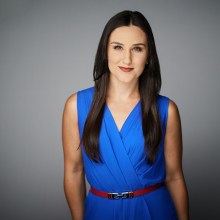
Inflation rises 2.9% in 2024 as consumer prices heat up heading into 2025
Published UpdatedBy Simone Del Rosario (Business Correspondent), Brent Jabbour (Senior Producer), Emma Stoltzfus (Video Editor), Mohammed Ali (Motion Graphics Designer)
Inflation continued to head in the wrong direction in December. Consumer prices rose 2.9% on the year, hotter than the 2.7% rise in November.
Media Landscape
See how news outlets across the political spectrum are covering this story. Learn moreBias Distribution
Left
Right
Untracked Bias
On the month, prices rose 0.4%, the highest monthly rise since February. In November, prices rose 0.3%.

Download the SAN app today to stay up-to-date with Unbiased. Straight Facts™.
Point phone camera here
It’s the third month in a row the key inflation gauge rose. It’s now at its highest point since July, according to Bureau of Labor Statistics data.
Experts believe the December rise in prices is fueled by higher food and energy costs. The energy index rose 2.6% on the month but is still down 0.5% on the year, while food is up 0.3% on the month and 2.5% on the year. Food prices are up about 25% over the past five years.
Core inflation, which strips out the more volatile food and energy indexes, came in slightly cooler than expected at 3.2% on the year, after several months at 3.3%. On the month, core prices rose 0.2%. Core inflation has not fallen below 3.2% since April 2021.
After peaking at 9% in June 2022, overall consumer prices started their long descent toward the Federal Reserve’s 2% inflation target. The Fed raised its benchmark interest rate to the highest level seen in decades to restrict the money supply and depress inflation.
In September, consumer price inflation reached 2.4%, but since then has climbed in the opposite direction.
“While we do not believe progress in the fight against inflation is going into reverse, we do see it stalling this year as earlier tailwinds to disinflation from supply chain improvements and lower commodity prices have faded and as fresh headwinds from trade policy are likely to emerge,” Wells Fargo economists Sarah House and Aubrey Woessner wrote in a note previewing the December report.
New trade and immigration policies from the incoming Trump administration are also Federal Open Market Committee member minds. The committee sets the Fed’s rate.
In December, members projected overall inflation will increase slightly in 2025, while core inflation will decrease.
Get up to speed on the stories leading the day every weekday morning. Sign up for the newsletter today!
Learn more about our emails. Unsubscribe anytime.
By entering your email, you agree to the Terms & Conditions and acknowledge the Privacy Policy.
“Almost all participants judged that upside risks to the inflation outlook had increased,” minutes from the meeting read. “As reasons for this judgment, participants cited recent stronger-than-expected readings on inflation and the likely effects of potential changes in trade and immigration policy.”
In that December meeting, members still forecast two interest rate cuts in 2025. However, probability markets are penciling in just one cut in July as of Wednesday morning.
The latest consumer inflation report follows last week’s jobs report. It showed the U.S. economy added 256,000 jobs in December, roughly 100,000 more than expected.
Simone Del Rosario:
If you didn’t get a 2.9% inflation raise this year, you’re making less than you were a year ago.
That’s how much consumer prices rose on the year ending in December, after rising 2.7% in November.
It’s the third month in a row the key inflation gauge has gone up. It is now at its highest point since July, according to Labor Department data.
Experts believe the December rise in prices is fueled by higher food and energy costs. The energy index rose 2.6% on the month but is still down 0.5% on the year. Food is up 0.3% on the month and 2.5% on the year. Food prices are up about 25% over the past five years.
Core inflation, which strips out the more volatile food and energy indexes, came in slightly cooler than expected at 3.2% on the year. That comes after several months stuck at 3.3%. Core inflation has not fallen below 3.2% since April 2021.
“Excluding food and energy, the inflation picture looked better,” Wells Fargo economists wrote in a note.
After peaking at 9% in June 2022, overall consumer prices started their long descent toward the Federal Reserve’s 2% inflation target. The Fed raised its benchmark interest rate to the highest level seen in decades in order to restrict the money supply and depress inflation. In September, consumer price inflation reached 2.4%, but since then has climbed in the opposite direction.
Wells Fargo economists said, “We believe the resiliency of the U.S. labor market, stickiness in inflation and uncertainty emanating from federal economic policy will keep the [Federal Open Market Committee] on hold for the next several months.”
The FOMC sets the Fed’s interest rate policy. The group confirmed new trade and immigration policies from the incoming Trump administration are also on their minds. In December, members projected overall inflation will increase slightly in 2025, while core inflation will decrease.
Minutes from their December meeting showed almost all participants thought the upside risk to inflation increased. “As reasons for this judgment, participants cited recent stronger-than-expected readings on inflation and the likely effects of potential changes in trade and immigration policy.”
In that December meeting, members still forecast two interest rate cuts in 2025, though probability markets are penciling in just one cut in July as of Wednesday morning.
The latest consumer inflation report follows last week’s jobs report, which showed the U.S. economy added 256,000 jobs in December, roughly 100,000 more than expected.
Media Landscape
See how news outlets across the political spectrum are covering this story. Learn moreBias Distribution
Left
Right
Untracked Bias
Straight to your inbox.
By entering your email, you agree to the Terms & Conditions and acknowledge the Privacy Policy.
MOST POPULAR
-
 Getty Images
Getty Images
Trump administration lays off as many as 2,000 Energy Department employees
Watch 2:0112 hrs ago -
 Getty Images
Getty Images
Elon Musk’s DOGE pays visit to IRS as millions file tax returns
Watch 3:3412 hrs ago -
 Getty Images
Getty Images
After a reported hack, DOGE website is live with ‘receipts coming soon’
Watch 5:1514 hrs ago -
 Getty Images
Getty Images
Mexico threatens to sue Google over ‘Gulf of America’ name change
Watch 1:4614 hrs ago




